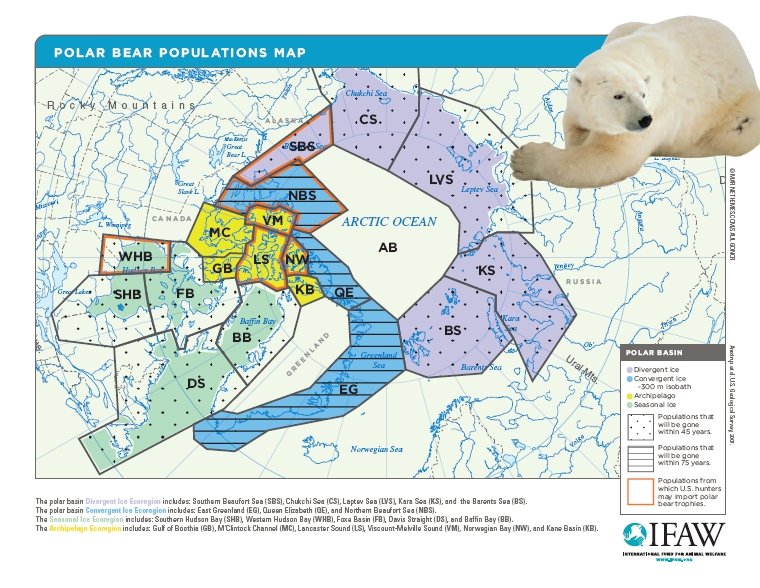Black oil, white bears and the color of money


The auction's over and the feds may rake in nearly three billion dollars for leases on land nobody will ever see. Land in the new oil and gas leases is far from shore and deep beneath the surface of the sea. A surface that may be rising because of global warming. But that did not stop oil and energy companies from bidding nearly $2.7 billion for exploration rights under the Chukchi Sea off northern Alaska. The cost to bring any oil to shore from there will be substantial.
Alaskan media morosely pointed out none of the lease payments will go to the state, only to the national government. Seven global oil companies bid. Royal Dutch Shell led with $2.1 billion in winning bids, followed by Conoco with more than $506 million. Other bidders included: Spanish firm Repsol, Italian-based Eni, and Norway's Statoil Hydro.
There's a review period during which the U.S. agency in charge will study the bids. Meanwhile political opposition is vocal and includes Native Alaskan groups and members of Congress. Some Congressmen had asked that the leases not be opened for bids until there is a final decision on the conservation status of the polar bear. But the Interior Department moved ahead.
One of Alaska's two polar bear populations hunt in the Chukchi Sea where the leases lie. While one part of the Interior Department opened the leases for bid, another last month postponed a decision on whether to grant endangered status to the polar bear. There are currently about 2.000 polar bears in the Chukchi region according to the U.S.G.S. and the population is a target of widespread poaching along the Siberian shoreline. 2,000 is a small number. More people attend many high school basketball games. That's how many bloggers can fit on the head of a pin.
Today I spoke with Program Officer Paul Todd of the International Fund for Animal Welfare. He indicated the polar bear may get hit with a triple whammy. Already the U.S. Geological Survey issued a report on the threat to polar bear, walrus and other arctic mammals from global warming and melting ice sheets. Todd wanted to explain why his group is worried that the two branches of the U.S. Interior Department are making decisions that could doom polar bears. He talked of how the oil exploration will necessarily mean disturbance of the ice sheets in the Chukchi Sea. That's an important hutning area for one bear population.
If the next Interior Department decision is to NOT list the polar bear as endangered, it would leave the U.S. government a great deal of leeway in setting any bear protection regs for the Chukchi Sea. Merely "threatened" status would not necessarily limit what could be done in the bear's hunting territory, said Todd. "Endangered" would carry some more specific limitations on what could be done by oil companies. Any bets on which way the current Interior Department will rule?
It's noteworthy that the World Conservation Union put the polar bear onto its Red List in 2005, meaning it's considered in danger of extinction globally. Of course, that's a list based on science and population trends, ignoring the niceties of politics and the price of oil. You'll be relieved to note that petroleum geologists and tech bloggers are NOT on the the Red List.
Another crucial issue for the survival of polar bears is trophy hunting. It's illegal in the U.S. but allowed in Canada which has the most polar bears. In the U.S. polar bear hunting is blocked by the Marine Mammal Protection Act. Todd said Canada's endangered species laws are weaker than those in the U.S. Anybody with enough money can get a license to hunt a polar bear in Canada. Some are killed by Native Americans but permits are also sold off for profit, in trophy hunting packages that can cost as much as $30,000. Of that only a $750 Canadian government permit fee goes to conservation. Nearly a thousand Americans have legally imported polar bear trophies in the past decade. Business as usual. Todd said the Russian polar bears are protected from hunters but not from the shrinking polar ice and may be the first populations to disappear.
If the polar bear is found to be endangered, that would in turn endanger trophy hunting. American citizens would NOT be allowed to bring dead bear claws or skins back to hang in the front hall. That would severely limit the market for those costly polar bear trophy hunts, and might incidentally save some bears.
Todd pointed out it was a Canadian university that studied trophy hunting and found it could increase the danger of polar bear extinction. Only large males are hunted and that could make it harder for mature females to find a mate, thus reducing their reproductive success at a time when climate change is creating severe stress on all polar bears.
One website headline summarized it thus: "Oil and gas companies win, polar bears lose." Not just the bears, says Todd, but four species of northern seals, walrus and some Arctic dwelling whales that hunt beneath the ice. Of course, there's already a lawsuit to block the leases. And it's not likely to be settled before there's a new resident in the White House and a new Secretary of the Interior.